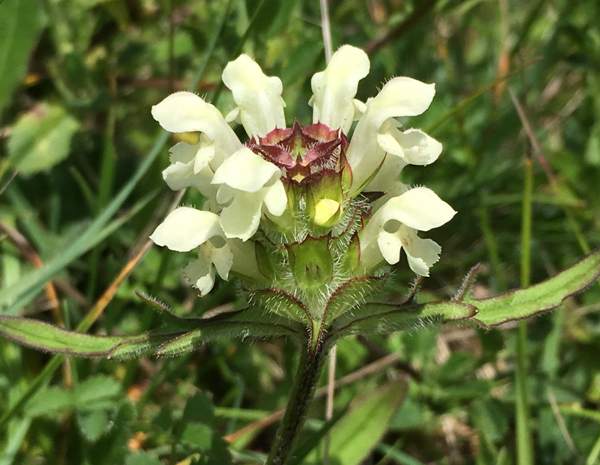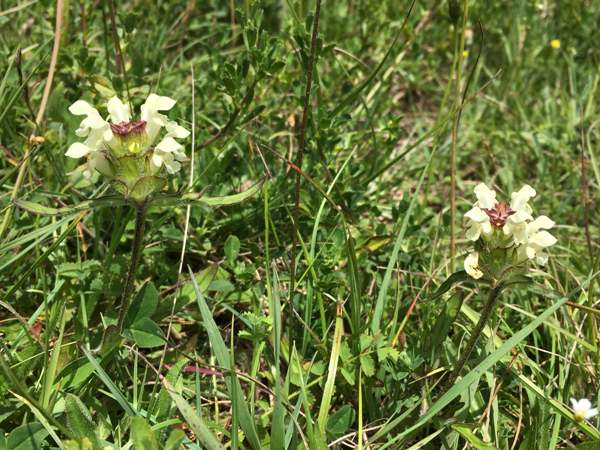Prunella laciniata - Cut-leaved Selfheal
Phylum: Magnoliophyta - Class: Equisetopsida - Order: Lamiales - Family: Lamiaceae

The rare wildflower was cultivated in Britain more than 300 years ago and is known to have been introduced to some sites when they were planted with imported clovers; nevertheless, Cut-leaved Selfheal is considered to be native to some grassland sites in Britain.
Description
This downy creeping perennial rarely grows taller than 30cm and often the flower heads are no more than 5 to 10cm above the ground. A distinguishing feature of this plant is the shape of its leaves, which are very deeply lobed, often with cuts almost to the central vein.

Box-shaped and usually oblong in side view, hardly tapering at all, the flower heads of Cut-leaved Selfheal with their white flowers are very distinctive. The individual two-lobed flowers are 10 to 15mm long. The upper lip is a helmet-like cowl, while the lower lip is divided into three lobes, the central lobe longer than the two side lobes.
Distribution
Prunella laciniata is localised in Britain, where it is found in a few sites mainly in southern England and southeast Wales, and it has been seen recently in at least one site in Ireland. This species is native to northern and central mainland Europe, and it is recorded as an introduced alien species in some eastern states of the USA, parts of South America, and south-east Australia.
Habitat
Selfheal is tolerant of poor soils and grows in meadows, hedgerows and ditches. This rapid coloniser of wasteland will persist even in grassy paths, lawns and public parks that are subject to frequent walking.

Blooming Times
The first flowers usually appear in early June, and Cut-leaved Selfheal usually continues flowering throughout the summer monjths.
Uses
The common name Selfheal, sometimes written as Self-heal, refers to plants of this genus having been used as a treatment for wounds and bruises until recent times.
Etymology
The generic name Prunella was given to this plant by the great Swedish naturalist Carl Linnaeus, who was aware of the use of Selfheal (Prunella vulgaris) as a treatment for the disease Quinsy; he intended to use the German term for Quinsy, which is die Braune, but unfortunately Linnaeus misspelled it as Prunella. Under the international conventions of botanical naming this error cannot be corrected and so Prunella it is. Girls who are given the name Prunella may feel better about it knowing that its origin is an unambiguous reference to a pretty wildflower rather than a name shared with an unpleasant streptococcal infection of the tonsils!
The specific epithet laciniata is Latin and means 'divided into many narrow lobes' - a reference to the deeply cut form of the leaves of this plant.
Similar Species
Selfheal Prunella vulgaris usually has purple or mauve flowers and oval leaves that are untoothed or only finely toothed; it is very common and widespread across Britain and Ireland.
Acknowledgements
This page includes pictures kindly contributed by Simon Harding.
Please Help Us: If you have found this information interesting and useful, please consider helping to keep First Nature online by making a small donation towards the web hosting and internet costs.
Any donations over and above the essential running costs will help support the conservation work of Plantlife, the Rivers Trust and charitable botanic gardens - as do author royalties and publisher proceeds from books by Pat and Sue.



